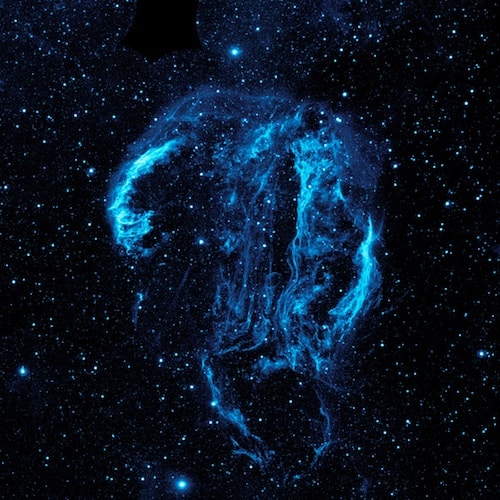 Intelligent Design
Intelligent Design
 Physics, Earth & Space
Physics, Earth & Space
SETI Sees the Light! Or Then Again, Maybe Not

Looking for alien radio signals? That’s so 1960. The current trend, NASA’s Astrobiology Magazine reports, is looking for light — the fading flashes of laser light beamed at us by intelligent beings longing to communicate across the vast emptiness of space.
Prior attempts to look for alien laser signals concentrated on isolated and intense bursts of light. Now scientists are focusing on repetitive but much fainter laser signals received over a longer amount of time. (Emphasis added.)
Some might remember the excitement in 1967 when the first pulsar was discovered sending repetitive flashes. Jocelyn Bell told her thesis advisor about a radio source pulsing with great regularity. After ruling out radio noise, they made a design inference: this must be a beacon from an alien civilization! They named it LGM-1, for “little green men” (read the rest of story at Wikipedia).
Their inference was premature, history showed, because a natural cause was soon found. If they had used Dembski’s Design Filter, they would have made more of an effort to rule out natural causes before telling the press they had found intelligent life in space.
It’s not just regularity, but “unnatural” regularity that might justify a design inference. Does the new SETI distinguish between natural and unnatural sources? Now that astronomers can “detect signals as faint as a single photon of light every few tiny fractions of a second,” how will they avoid being fooled again?
In contrast, laser scientist Walter Leeb at the Vienna University of Technology in Austria and his colleagues are focusing on repetitive, faint laser signals received over a sufficiently long amount of time.
“We assumed that aliens would use the simplest possible way of attracting our attention, one already implemented in seafaring since ancient times using lighthouses — that is, periodic light pulses,” Leeb said.
So far, this sounds like another setup for folly. Pulsars give out periodic radio or light pulses, too, but they are not lighthouses made by intelligent aliens. What’s the difference? The difference is in ruling out known natural sources:
The kinds of strings of pulses the researchers are looking for, each roughly nanoseconds or billionths of a second long, are not likely found in nature. “Such signals can, however, be generated by lasers,” Leeb said, thus hinting at an extraterrestrial intelligent origin.
Because repetitive signals stand out from the background noise, they are easy to detect. Still, what’s the difference between that and pulsars, which can be so regular they can be used as precision clocks?
Leeb did note that astronomical objects known as pulsars also give off repetitive light pulses. “However, their signals have a rather low repetition frequency, and do not consist of nanosecond pulses an extraterrestrial intelligence will possibly use,” he said.
So it’s nanosecond pulses that they want. But maybe a natural source will turn up that does use nanosecond pulses. How will they know? The SETI researchers believe they understand how intelligent minds think:
Since current technology on Earth is capable of powerful visible and near-infrared lasers, the scientists assumed extraterrestrials might be as well. They reasoned aliens would choose wavelengths that would stand out from the light from their home stars as well.
From there, the article digresses into technical details of detecting faint laser light. It would seem, though, that if such laser pulses are ever detected, astrobiologists will have to spend quality time ruling out possible natural sources to avoid announcing LGM-2.
The Design Inference
Intelligent design advocates do not get excited about regular pulses, because the information content is low. If you saw the flashing light on a lighthouse from a distant ship, and had never seen one before, would you know it was intelligently designed? Perhaps so, but the inference would be weak. The signals bearing the most information are irregular, or aperiodic — like written text, program codes and DNA.
An aperiodic signal would be more difficult to discern, though, from background noise — unless all natural sources for the laser light could be ruled out with certainty. That’s why “low probability” and “specification” are part of the design inference. A regularly pulsing laser would carry very little information, whereas a laser beaming an irregular stream of pulses might carry a message (in the movie Contact, it was a string of prime numbers). From the particulars of an aperiodic signal, it would be possible to infer alien intelligence, even without knowing the language.
But regularity is a start. It’s partway down the Design Filter. Even a repetitive set of pulses could imply design, if the type of light, the spacing of the pulses, and the length of time defy natural causation. Once able to rule out chance and natural causes, the options other than intelligence are few. Undoubtedly the SETI researchers would be highly optimistic that they had detected alien intelligent design.
The SETI researchers also mimic what ID advocates do by reasoning about known behaviors of intelligent minds. We know from uniform experience that minds are capable of sending messages across space, because we have done it ourselves (recall the Arecibo message of 1974). Similarly, the SETI researches reason about what aliens would do, based on how our minds work. Since human engineers are careful to have a high signal-to-noise ratio, “They reasoned aliens would choose wavelengths that would stand out from the light from their home stars as well.”
If SETI researchers would feel justified in drawing a design inference based on a few photons of laser light, how much more should they recognize the evidence for design in the enormous information content in DNA? They’ve already disavowed methodological naturalism by accepting the possibility of intelligent causes for light signals. Whether or not they ever see the light they’re looking for, we hope they will see the light all around them.
Image: Cygnus Loop Nebula, NASA/JPL-Caltech.
